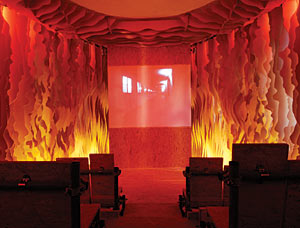In the catalog for Antony Gormley’s recent exhibition, Blind Light, at the Hayward Gallery in London, the curator Jacky Klein cites Brancusi’s dictum that “architecture is inhabited sculpture.” But since the onset of the Constructivist movement in Russia in the early 20th century, sculpture itself has become architectonic and inhabited, if not physically, then mentally, in the seductive manner that the imagination allows the viewer to experience its interiority.'


Not satisfied merely to imply habitation, two artists developed sculptural projects this year that work as architecture and engage viewers to complete the perceptual concepts behind them: Tobias Putrih’s Venetian, Atmospheric, which represented Slovenia at the 52nd International Art Biennale in Venice, and Gormley’s Blind Light at the Hayward. Both extract ideas from the artists’ early memories of buildings and the consciousness of the self within space to produce a transforming experience for others.
As an artist, Putrih became enchanted by the fantasy world of old movie palaces from the 1920s and ’30s, buildings that mediated between drab streets and the projection of celluloid fictions. He was also fascinated by multiplex cinemas and made cardboard models with white, ribbonlike screens that countered the blandness of the generic interiors. At Manifesta4 in Frankfurt in 2002, he put three of these small cardboard constructions (of theaters in Frankfurt) on pedestals, indicating his talent for encapsulating an illusion.
Transfixed by the theater’s vanishing role as both a social venue and an escapist mechanism, Putrih envisioned a model that would suggest a fantasy environment and be large enough to function as a real space for gathering people. Taking his cue this time from London’s Art Nouveau Odeon theaters from the 1930s and the 1928 New Victoria Theatre designed in German Expressionist style by Ernest Wamsley Lewis, he worked in 2005 with architect Luka Melon to build a “cineclub” at the Thomas Dane gallery in London. Called A Certain Tendency in Representation, after an essay by François Truffaut, the piece had a cardboard floor; slatted, undulating plywood walls; and foam-cushioned seats, all bathed in the same warm glow of yellow and red lighting found in Lewis’s theater. Though films were projected on a regular basis, the “model” itself was the show.
Now based in New York, Putrih has discovered the paragon of the “atmospheric” movie palaces in Loew’s 1929 Paradise Theater on the Grand Concourse in the Bronx. The auditorium is surrounded by elegant Venetian Baroque–style facades with sculpture niches, colonnades, and exuberant carving creating the illusion of being in a Venetian campo, making it a kind of Teatro Olimpico all’americana. The designer of this and a hundred other such places was the Romanian-born American architect John Eberson, who fairly invented the idea of turning cinemas into illusory settings of exotic locales.
After creating a series of evocative collages from torn photographs of the Paradise’s interior and drawings tracing the longitudinal outlines of its decorative elements, Putrih built Venetian, Atmospheric as a full-fledged, freestanding cinema. A major sculptural attraction of the Biennale, it brought Venice, inspired by Eberson, back to its origins. Before reaching the piece, though, visitors stopped at Galleria A+A near the Palazzo Grassi, which served as an orientation to the main event and included the scored drawings of the Paradise’s interior.
The setting for Venetian, Atmospheric itself was not a crowded campo or the Giardini, cheek by jowl with other national exhibitions, but isolated under tall trees on the bucolic Island of San Servolo at the picturesque campus of Venice International University, the site of a former Benedictine monastery. Traveling the 10 minutes by vaporetto from Piazza San Marco, away from the hurly-burly of the city and the biennale, provided a welcome respite to clear your mind and prepare for a remarkable project.





